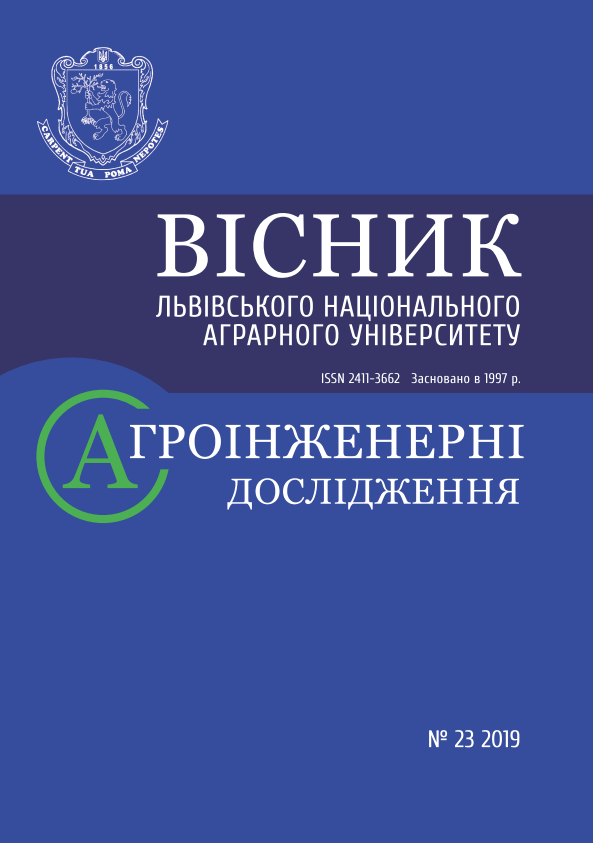STRUCTURAL-MATHEMATICAL MODELING OF THE DIFFERENT METHODS OF INITIATING AN INDUCTION MOTOR
DOI:
https://doi.org/10.31734/agroengineering2019.23.075Keywords:
induction motor, start, structural and mathematical model, transient processesAbstract
The work determines problem of frequent starting of electric motors in the mechanisms, operating in repeated-short-term modes, as well as energy saving during start-up. In production processes, the most extensive use is inherent in an induction motor with a short-circuited rotor. The analysis of publications has shown the feasibility of conducting research in the above-mentioned direction to provide the best technical and economic indicators, as well as the use of a regulated electric drive, the use of converters between the network and the electric motor, etc. The research objective is to investigate the various methods of starting of an induction motor with the help of a structural and mathematical model of the induction motor in MATLAB / Simulink environment, as well as additional equipment. The purpose of the work is to investigate the various methods of starting an induction motor with a short-circuited rotor, using the constructed models. The research described a constructed structural-mathematical model of induction motor with a short-circuited rotor, as well as additional equipment: switching by the "star-triangle" scheme, the device of smooth start-up, frequency converter. The article describes simulation of four methods of starting of an induction motor with a short-circuited rotor under load, particularly a direct one, with switching according to the "star-triangle" scheme, using a soft start device, with a frequency converter. The first two start-up methods provide a simple and inexpensive control scheme, and by means of technical means such as a soft start device and frequency converter, an adjustable and controlled start of the induction motor can be obtained, namely, the startup, introduction of restrictions, regulation or provision of a certain value of moment, starting current.
References
Ango, A. (1965). Matematika dlya elektro- i radioinzhenerov. Moskva: Vyissh. shkola.
Bessonov, L. A. (1973). Teoreticheskie osnovyi elektrotehniki. Moskva: Vyissh. shkola.
Bessonov, L. A. (2002). Teoreticheskie osnovy elektrotehniki: elektricheskie tsepi. Moskva: Gardariki.
German-Galkin, S. G., & Kardonov, G. A. (2003). Elektricheskie mashiny. Sankt-Peterburg: KORONA print.
German-Galkin, S. G. (2001). Kompiuternoe modelirovanie poluprovodnikovyh sistem v MATLAB 6.0. Sankt-Peterburg: KORONA print.
German-Galkin, S. G. (2007). Silovaia elektronika. Sankt-Peterburg: KORONA print.
Hrechyn, D. P., Herman, A. F., & Drobot, I. M. (2016). Kontynualna matematychna model elektromahnitnoho polia asynkhronnoi mashyny iz zubchatym feromahnitnym rotorom. Visnyk Lvivskoho natsionalnoho ahrarnoho universytetu: Ahroinzhenerni doslidzhennia. 20, 34–41.
Hrechyn, D. P., Drobot, I. M., Herman, A. F., & Dubik, V. M. (2016). Vplyv rozmiriv paza rotora na velychynu puskovoho momentu korotkozamknenoho asynkhronnoho dvyhuna. Zbirnyk naukovykh prats Podilskoho derzhavnoho ahrarno-tekhnichnoho universytetu. Tekhnichni nauky, 24(2), 47–54.
Zhulai, Ye. L., Zaitsev, B. V., Lavrinenko, Yu. M., Marchenko, O. S., & Voitiuk, D. H. (2001). Elektropryvid silskohospodarskykh mashyn, ahrehativ ta potokovykh linii. Kyiv: Vyshcha shkola.
Marchenko, O. S., Lavrinenko, Yu. M., Savchenko, P. I., & Zhulai, Ye. L. (1995). Elektropryvod. Kyiv: Urozhai.
Zakladnyi, O. M., Prakhovnyk, A. M., & Solovei, O. I. (2005). Enerhozberezhennia zasobamy promyslovoho elektropryvoda: navch. posib. Kyiv: Kondor.
Kliuchev, V. I., & Terehov, V. M. (1980). Elektroprivod i avtomatizatsiya obschepromyishlennyih mehanizmov. Moskva: Energiya.
Moroz, V. I., Paranchuk, Ya. S., & Kostyniuk, L. D. (2004). Modeliuvannia elektropryvodiv. Lviv: Vyd-vo NU “Lvivska politekhnika”.
Sokolova, E. M. (2001). Elektricheskoe i elektromehanicheskoe oborudovanie. Moskva: Masterstvo.
Eliseeva, V. A., & Shinianskii, V. A. (1983). Spravochnik po avtomatizirovannomu elektroprivodu. Moskva: Energoatomizdat.
Popovych, M. H., Borysiuk, M. H., & Havryliuk, V. A. (1993). Teoriia elektropryvoda. Kyiv: Vyshcha shkola.
Chaban, A. V., Levoniuk, V. R., Drobot, I. M., & Herman, A. F. (2016). Matematychne modeliuvannia perekhidnykh protsesiv u linii Lekhera v stani nerobochoho khodu. Elektrotekhnika i elektromekhanika, 3, 30–35.
Chaban, A. V. (2015). Pryntsyp Hamiltona – Ostrohradskoho v elektromekhanichnykh systemakh. Lviv: Vyd-vo Tarasa Soroky.
Chernyih, I. V. (2008). Modelirovanie elektrotehnicheskih ustroistv v MATLAB, SimPowerSistems i Simulink. Sankt-Peterburg: Piter.
Mayr, O. (1943). Beitriige zur Theorie des statischen und des dynamischen Lichtbogens. Archiv fur Elektroteehnik, 1943’37, 12, 588–608.


